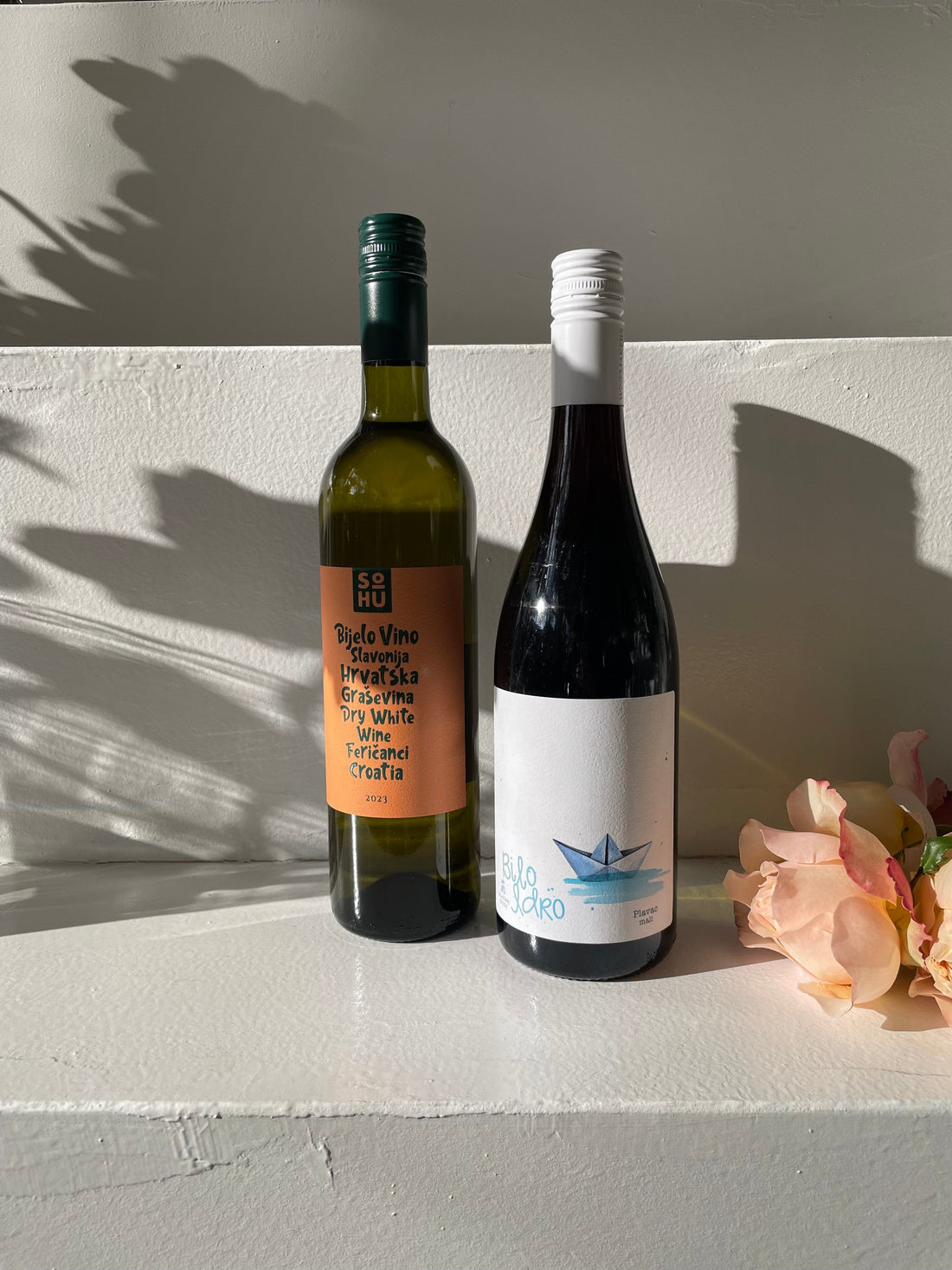
April 2025 - Croatia
April 2025
Croatia
Featuring:
Feravino / SoHu
Zlatan Otok
We first covered Croatia in February 2023. In reviewing research for this writeup, I came across a lot of the same information. With this, I decided it would be best to revisit that writeup rather than recycle the same concepts with new prose.
The History / Climate & Geography sections below are from that writeup. The featured wines are different. We are featuring Zlatan Otok in Dalmatia for a second time (but a different wine). SoHu is an entirely new producer to the Oregon market, brought to the state specifically for our wine club. Please enjoy!
History
There’s no reason Croatian wine can’t receive the same accolades as Italian or Greek wines. The history of grape growing is thousands of years old and as varied as those two countries. It shares many of the same climatic and geological influences - Mediterranean/Adriatic cooling influences, unique soil types, interesting native grapes, arid inland climate, and old vines. But there’s plenty of reasons it *currently* doesn’t. The first would be its relative youth as a country (and economy) embracing the quality over quantity aspect of capitalism, rather than Yugoslav pseudo-socialism. The second would be its quick descent into war after said independence. Third, many of the grapes are indigenous and hard for non-native speakers to fully understand.
In the 1970s, when Croatia was part of larger Yugoslavia, the whole country was one of the top-10 wine producing countries. And while the top-10 is impressive, a large majority of that was low-quality wine produced for local consumption and regional export. Private wineries like Bura did exist at the time, however they were required to give upwards of 60% of their crop to the government. This stifled most effort to create high-quality wines. That said, there was still some effort to produce quality wine - this article from the Washington Post archives (dated 11/9/1980) is an interesting look at the efforts of a Yugoslavian exporter trying to make an impression on the US market.
Once Croatia partially gained independence in 1991, a few intrepid winemakers staked their claim and founded wineries, including Zlatan. However it would be many more years, some tragically bloody, before the true Croatian wine renaissance came about.
Today, over 30 years since independence, the Croatian wine scene has fully blossomed. It is still a small fish in a big pond, producing just 70 million hectoliters a year, on par with Switzerland, Peru, or Uruguay. Not quite wine powerhouses on the global stage. However, if the quantity has stagnated, the quality of the wine has increased greatly. And they’re just getting started.
Climate and Geography
Croatia shares many similarities with its Mediterranean neighbors as far as both climate and geography. Growing regions range from the coast, which is heavily influenced by the cooling factors of the Adriatic Sea, to the inland plains, which see more severe continental weather patterns. The mountainous area between the coast and the inland areas (where the country narrows, between Slovenia and Bosnia & Herzegovina) is not home to any major designated wine regions, though I can guarantee that locals still grow grapes and make wine for at-home consumption or local sales.
The regions of ‘Uplands’ and ‘Slavonia’ in inland Croatia share many of the same characteristics as southern Hungary/northern Serbia - continental climate and a combination of volcanic and sedimentary soils from around the Danube river basin. Due to the heavy agricultural history of this area, plus relative ease of farming compared to the rugged coastline, the majority of Croatia wine production (by volume) comes from here.
In Istria, on the northern coast, one will find either white limestone soils or red, iron-rich soils. These iron-rich soils are considered very unique to the region and give many of the wines from Istria a sanguine characteristic (namely the reds). We hope to profile Istria as a unique region one day!
Further down the coast is Dalmatia, where our focus lies this month. Stretching from Zadar down the Pelješac Peninsula to Dubrovnik, this is the ‘picturesque’ Croatia that many imagine. Game of Thrones fans know Dubrovnik as ‘King’s Landing’ and tourism has exploded since the show. For history buffs, the town of Stari Grad on Hvar is considered one of the oldest towns in Europe (384 BC). On the remote island of Mljet, one can find Odysseus’ Cave, harkening back 3000 years of Greek History.
Here in Dalmatia, the soils are almost entirely Karst, white limestone that is highly permeable and prone to dissolving from rain/water. This low-moisture holding soil is pivotal in creating low-quantities of very high-quality wines, with deep roots and minimal irrigation. Most grapes will flourish on karst, but native grapes have always fared better than ‘international varieties’ in Croatia. In a bit of irony, this coastal, seafood loving region is the only wine region in Croatia that produces more red wine than it does white wine.
Feravino ‘SoHu’ Graševina, Fericanci, Slavonia 2023
Feravino is located in the village of Feričanci, Slavonia, Eastern Croatia, near both the Drava and Danube rivers. The area has a winegrowing history that dates back to the 13th century when Cistercian monks inhabited the area. This particular cellar was established in 1804 as a small village winery producing rustic wines for local consumption. Over generations, the winery evolved and began to focus on the local Graševina (Welshriesling) grape. It was nationalized under Yugoslav rule, but privatized again shortly after the fall of the Soviet Republic.
Feravino merged with a local agricultural company in 2015, allowing them the ability to expand production and seek an export partner. One of the early initiatives of the new winemaking team was to create a sub-label focused solely on the two indigenous varieties, Graševina and Frankovka (Blaufrankisch). They called it SoHu, a reference to the location (South of Hungary) and the shared history these two grapes has across the political border.
This wine is 100% Graševina grown on volcanic soils with clay stone over a bedrock of granite. The wine sees a southern exposure, which is helpful in the continental climate of Eastern Croatia (dry, warm summers with cold, snowy winters). The grapes are unirrigated, hand harvested, and fully destemmed before fermentation. The wine is fermented and aged in stainless steel for 10 months before bottling.
The finished product is a bright, refreshing white with notes of lemon and apple. On the palate, the wine has a richness and viscosity typical of the variety. There is a touch of phenolic bitterness on the finish that makes it a wonderful food wine - think cream sauce, butter, garlic, fatty fish, etc.
Side note, while the variety may be called ‘Welshriesling’ in Austria or Riesling Italico in Italy, it shares no genetics with Riesling and has very few similarities… don’t be fooled, this is just medieval wine marketing tactics at their worst.
Zlatan Otok, ‘Bilo idro’ Plavac Mali, Šibenik 2021
Zlatan was founded by Zlatan Plenković in 1991, right after the independence of Croatia from Yugoslavia. In fact, they were the second private winery to be founded after the split. In that relatively short amount of time, they’ve made a big splash; often being considered the most awarded winery in Croatia and Zlatan as the ‘father of modern Croatian wine’.
The principal winery is located in Sveta Nedjelja, on the southern coast of the Island of Hvar. Here, they farm 10 hectares of vineyards and purchase from an additional 80 hectares, making them by far the largest producer on the picturesque island. On the mainland, they farm an additional 75 hectares in Baška Voda, home to their larger facility, and 65 hectares near Šibenik (halfway between Split and Zadar). As a whole, the winery produces 75,000 cases per year of white, red and rosé wines! Their tasting room on Hvar is located in a beautiful private marina, called Bilo idro. While I haven’t been myself, this video makes me think it’s a must-visit.
Though this cuvee is named after the marina on Hvar, it comes from further up the Dalmatia coast. The vineyard is located in the settlement of Vrpolje, on the outskirts of the coastal city of Šibenik. Vineyards sit at ~ 150 to 900 ft of elevation, with a west facing view affording them afternoon sun and beautiful sea views (jealous). While daytime temperatures are warmer in Northern Dalmatia, the nighttime temps are cooler, allowing brighter acidity and full phenolic ripeness.
Grapes are grown organically in red clay atop limestone bedrock. Wine is macerated for 8 days in stainless steel tanks before pressing and finishing fermentation. It is aged for an additional 18 months in steel before bottling with a light fining but no filtration.
Stylistically, this is a lighter Plavac Mali that accentuates the freshness and light berry character of the variety. Aromatically, it has notes of dark cherries, blueberries and earthiness, with gentle tannins and bright acid on the palate. This wine could be chilled and enjoyed on a warm day (coming soon!) or drank at cellar temp with a simple meal of roast vegetables with olive oil and goat cheese.
